Key takeaways:
- Mastering Thai cooking involves understanding key techniques such as stir-frying and balancing flavors of sweet, sour, salty, and spicy.
- Utilizing essential tools like a wok, mortar and pestle, and fresh ingredients enhances the quality and authenticity of Thai dishes.
- Avoid common mistakes including using non-fresh ingredients, overpowering flavors, and rushing the cooking process to achieve richer, more harmonious dishes.
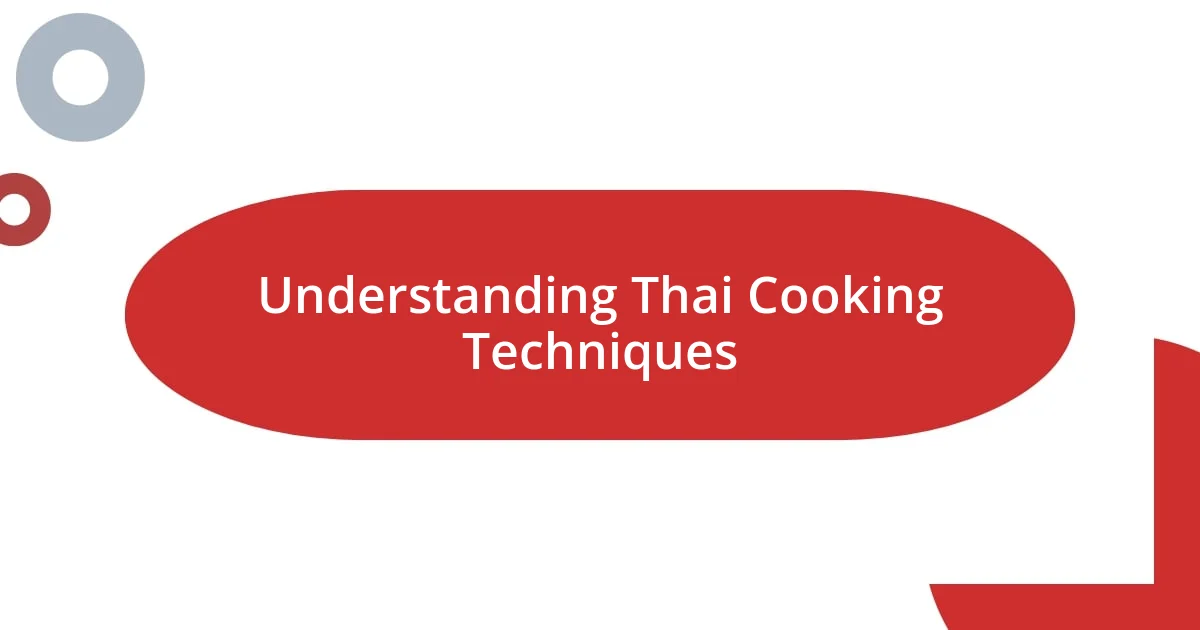
Understanding Thai Cooking Techniques
Thai cooking techniques are a fascinating blend of precision and artistry. I remember observing my friend’s grandmother expertly wielding a mortar and pestle; she turned humble ingredients into a fragrant curry paste with effortless grace. Have you ever experienced how the right tools can elevate cooking?
One core technique in Thai cooking is stir-frying, a method that allows flavors to meld quickly while maintaining the freshness of the ingredients. It’s thrilling to watch—ingredients sizzle and colors brighten before your eyes! I often wonder how such a simple technique can produce dishes so bursting with flavor; it’s all in the timing and temperatures, which I’ve learned through a few delicious trials and errors in my kitchen.
Another important aspect is balancing flavors: sweet, sour, salty, and spicy. Each dish tells a story through these contrasts. During a recent family dinner, we made a green papaya salad that captured this balance perfectly, leading everyone to ask for my secret. It’s a reminder that understanding these techniques is not just about cooking; it’s about creating a shared experience that resonates with everyone at the table.
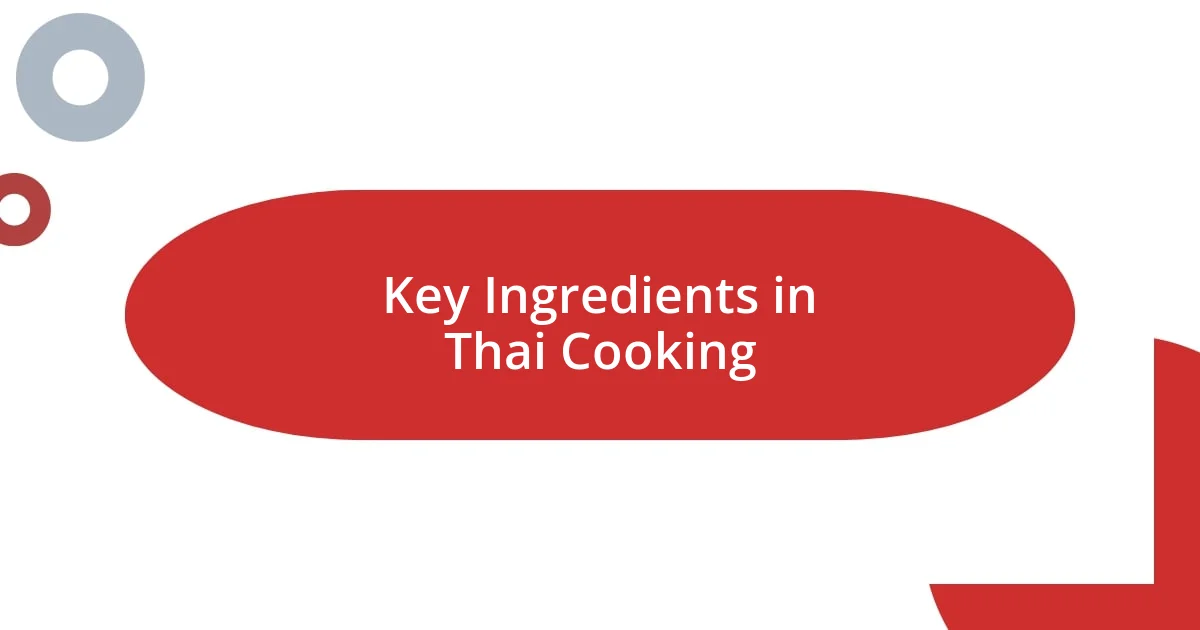
Key Ingredients in Thai Cooking
There’s a vibrant palette of ingredients that truly define Thai cooking. When I first tasted Thai basil, the flavor was like a revelation. It’s not just about the taste; its aromatic quality immediately transports me to the bustling markets of Thailand. Similar to the significant role of lemongrass, which adds a zesty kick, these key ingredients are integral to the unmistakable Thai flair.
Chilies deserve a special mention as well. Initially, I was hesitant about using them due to their heat. However, I soon realized how they can transform a dish from bland to extraordinary. In fact, the first time I made a spicy green curry, my friends and I felt like we were on a culinary adventure. Who knew a handful of chilies could bring such excitement to dinner?
Then there’s fish sauce, an elixir that is often underrated. I remember the first time I used it in a recipe; it seemed so intimidating. Yet, it beautifully enhances umami, pulling all the ingredients together in harmony. It was a total game-changer for me. The balance and depth it adds to dishes are simply irreplaceable. Let’s explore these ingredients further in the table below.
| Ingredient | Flavor Profile |
|---|---|
| Thai Basil | Aromatic, slightly sweet |
| Lemongrass | Citrusy, zesty |
| Chilies | Spicy, varying heat |
| Fish Sauce | Salty, umami-rich |
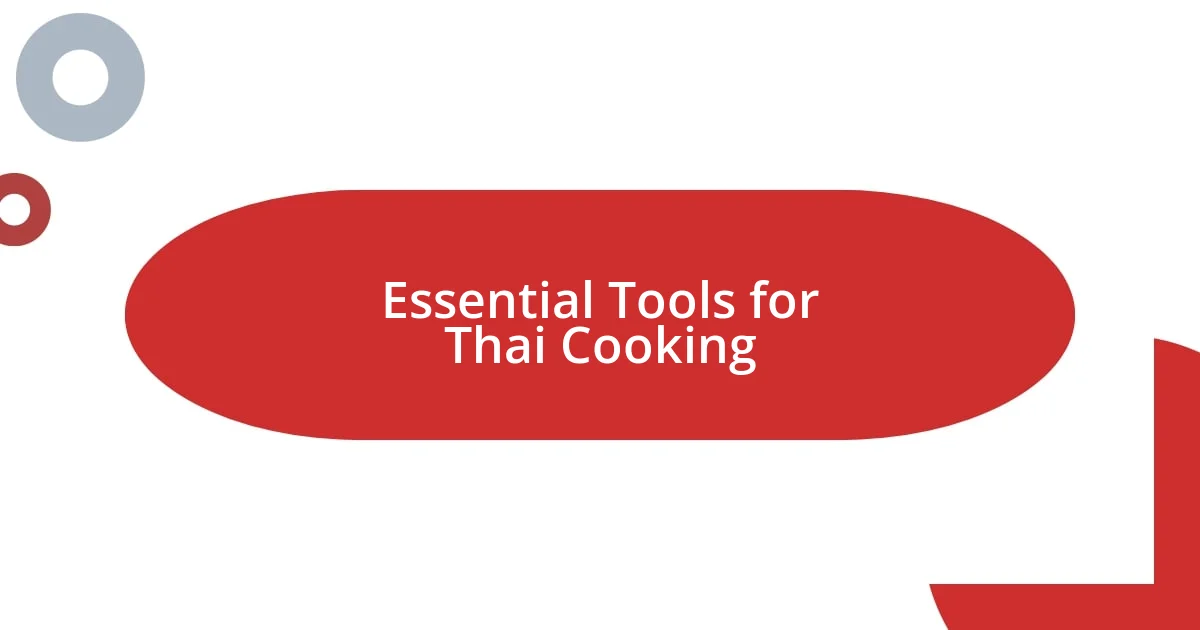
Essential Tools for Thai Cooking
When it comes to mastering Thai cooking, having the right tools can make all the difference. I remember the first time I used a wok. The way it conducts heat and allows for quick, high-heat stir-frying completely transformed my dishes. The rounded shape is perfect for tossing ingredients, which keeps them vibrant and crisp—essential for those mouthwatering stir-fried dishes we all crave.
Here are some essential tools for anyone looking to dive into Thai cooking:
- Wok: Ideal for stir-frying, stewing, and deep-frying. Make sure to choose a heavy-bottomed one for even heat distribution.
- Mortar and Pestle: Perfect for grinding spices and making curry pastes; the texture it provides is unmatched.
- Mandoline Slicer: Helps achieve those uniform, delicate vegetable slices that are visually appealing in dishes.
- Chef’s Knife: A sharp, high-quality knife is essential for chopping and dicing, ensuring you can work efficiently in the kitchen.
- Steamer: Whether bamboo or stainless steel, this tool is great for preparing rice or vegetables while retaining nutrients.
Another tool that deserves special mention is the rice cooker. I still remember the delightful aroma that filled my kitchen the first time I used one. While cooking rice on the stovetop is entirely possible, there’s something incredibly satisfying about hitting a button and walking away. You return to perfectly steamed rice, ready to accompany your favorite Thai curry. It’s a labor-saver that truly enhances the overall cooking experience.
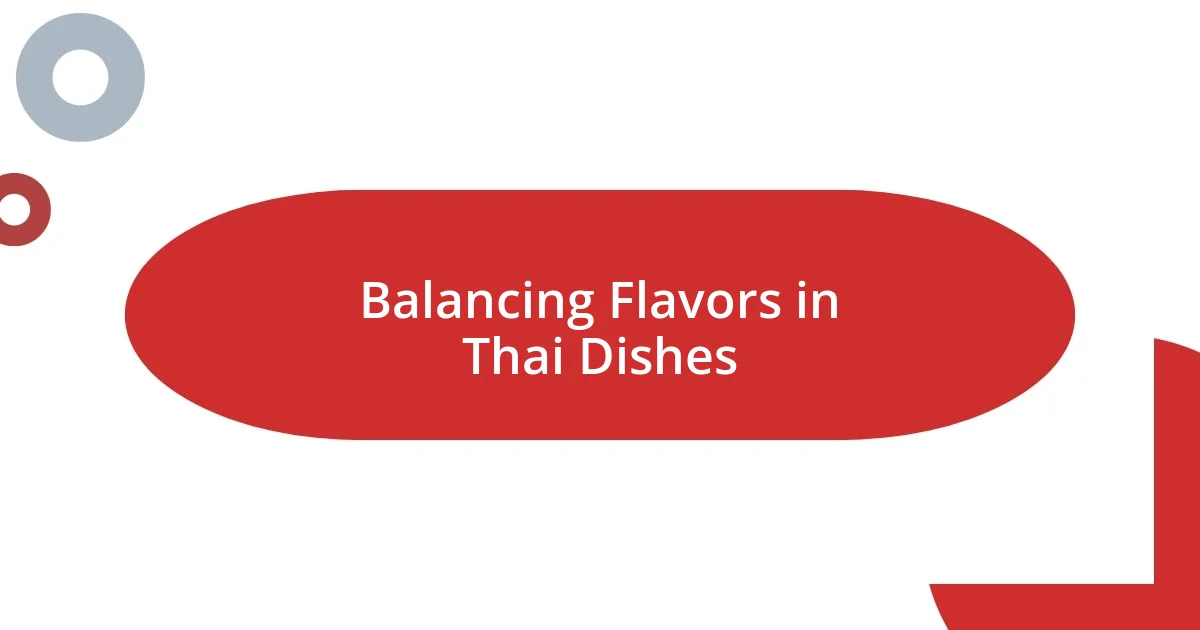
Balancing Flavors in Thai Dishes
Finding the right balance of flavors in Thai dishes is like composing a symphony. Each component—sweet, sour, salty, and spicy—plays its part in creating a harmonious dish. I vividly remember the first time I made Pad Thai. I was nervous about how the tamarind would interact with the fish sauce and sugar. But when I finally tasted it, the way everything came together was like a lightbulb moment.
A crucial part of this balancing act involves adjusting flavors as you cook. I often start with a bit of sweetness from palm sugar and then gradually add tart tamarind. It’s fascinating how a mere pinch can change the dynamics. Have you ever added a splash of lime juice and felt the dish come alive? That zest transforms a meal, elevating it from mundane to extraordinary.
What I love most about Thai cooking is its adaptability. If a dish feels too salty, adding a touch of sugar can create a wonderful contrast. I recall experimenting with a green papaya salad, and it was eye-opening to realize how a little chili and sugar could turn a delicate salad into a vibrant flavor explosion. Each bite taught me the importance of tasting and adjusting—my key takeaway from countless Thai cooking sessions.
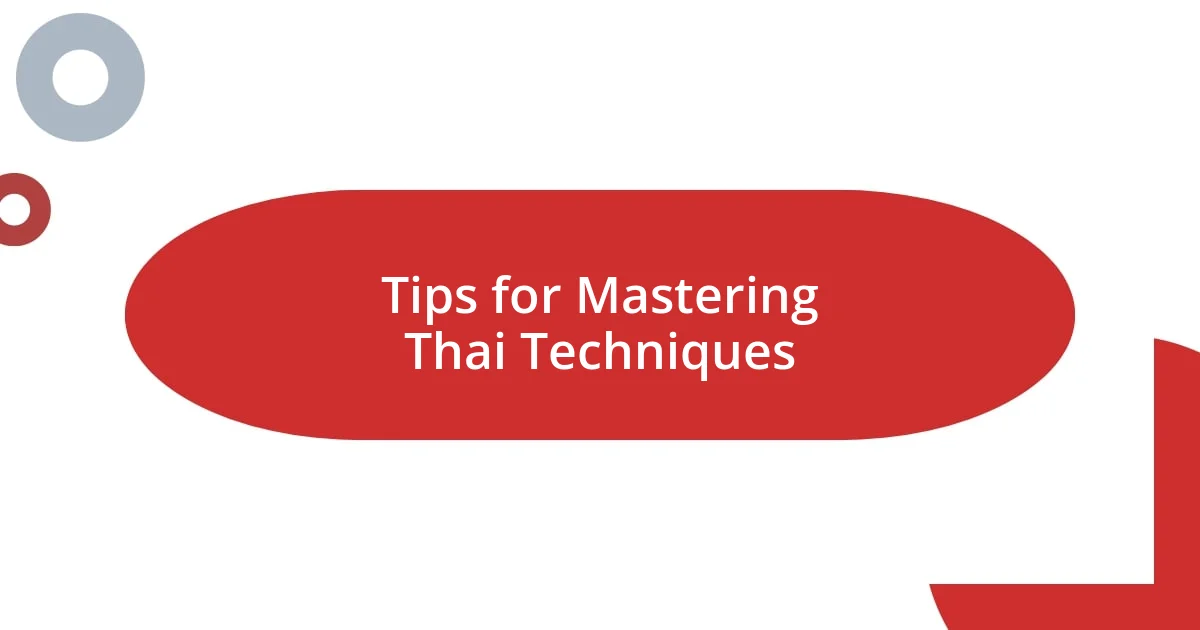
Tips for Mastering Thai Techniques
One of the best tips I can offer for mastering Thai techniques is to embrace the art of mise en place. This French term simply means “everything in its place.” I recall the first time I prepped ingredients this way before making a green curry; it not only made the cooking process smoother, but it also allowed me to appreciate each ingredient’s color and texture. Have you noticed how much easier it is to stay focused on cooking when everything is ready to go? I find that it helps me to avoid that last-minute scrambling, which can lead to mistakes and mishaps.
Another crucial aspect to consider is heat control. I remember the first time I cranked my burner to high while stir-frying; I was amazed at how quickly the vegetables cooked, preserving their crunch and vibrant colors. However, it took me a few trials to understand when to adjust the heat down to medium for a slow simmer—this shift can deepen flavors without the risk of burning. When cooking Thai food, do you find yourself second-guessing that perfect heat level? It’s a learning curve, but once you nail it, those beautifully harmonious flavors emerge effortlessly.
Finally, never underestimate the power of fresh ingredients. I still cherish the experience of visiting a local Thai market for the first time, surrounded by the aromas of lemongrass and galangal. There’s something indescribably rewarding about using fresh herbs and spices straight from the source. Do you remember the first time you tasted a dish made with truly fresh ingredients? The flavors are on another level! Trust me, investing in quality produce not only elevates your dishes but also adds authenticity, making you feel like you’re in the heart of Thailand with each bite.
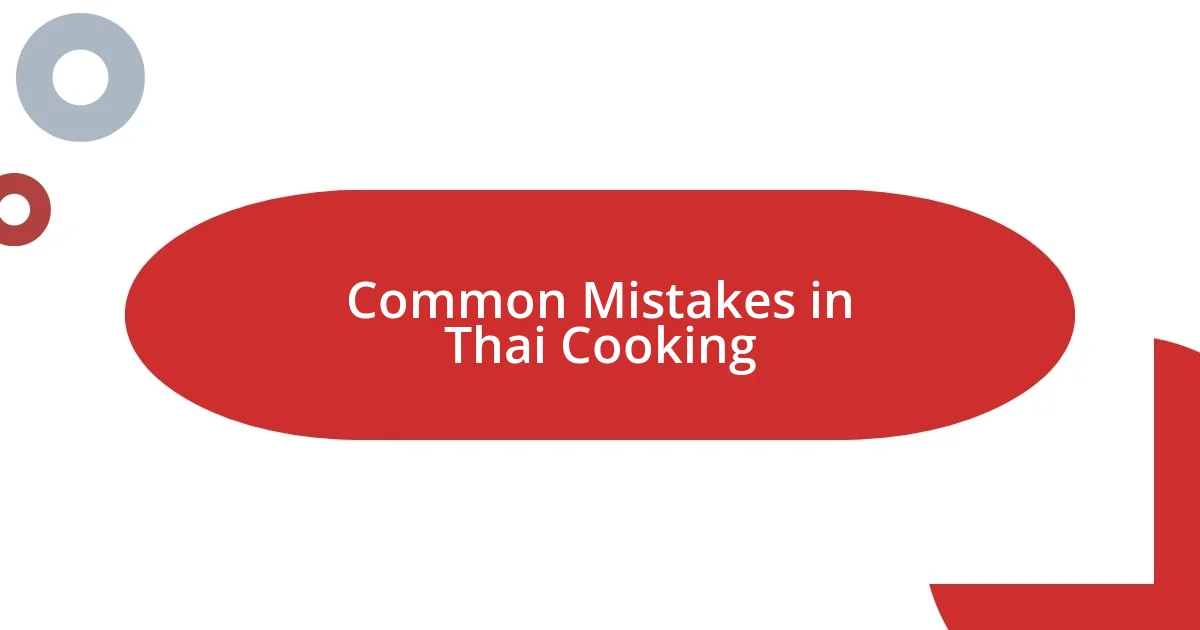
Common Mistakes in Thai Cooking
One common mistake I’ve made in Thai cooking is underestimating the importance of ingredient freshness. There was a time when I grabbed some packaged herbs instead of fresh ones. As I stirred my curry, I couldn’t shake off the feeling that something was simply off. It struck me how vital fresh ingredients are to Thai dishes—one can have a great recipe, but without vibrant herbs, it’s like playing music without the right notes.
I also remember the first time I added too much fish sauce to a dish. I thought, “More must be better,” but I quickly learned that balance is key. The overpowering saltiness turned what could have been a delightful dish into something unappetizing. Have you ever felt the heart-sinking moment when you realize your dish is beyond saving? Now, I always start with a little, tasting as I go to hit that sweet spot of umami without overwhelming the other flavors.
Another pitfall I encountered was rushing through the cooking process. In my eagerness to enjoy a steaming bowl of Tom Yum soup, I threw in all the ingredients at once—big mistake! The flavors didn’t have time to develop, leaving me with a watery broth instead of a rich, layered taste. It’s a reminder that patience is a virtue in Thai cooking. Have you ever had to remind yourself to slow down and let the magic happen? Taking those extra moments can be the difference between a mediocre meal and a memorable one.















